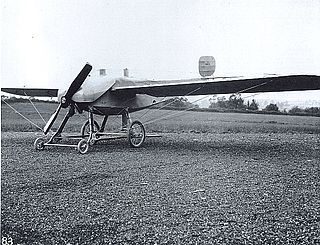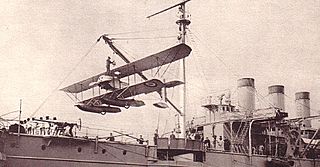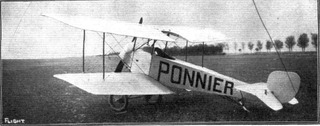Related Research Articles

The Boxkite was the first aircraft produced by the British and Colonial Aeroplane Company. A pusher biplane based on the successful Farman III, it was one of the first aircraft types to be built in quantity. As the type was used by Bristol for instruction purposes at their flying schools at Larkhill and Brooklands many early British aviators learned to fly in a Boxkite. Four were purchased in 1911 by the War Office and examples were sold to Russia and Australia. It continued to be used for training purposes until after the outbreak of the First World War.

The Bristol Scout was a single-seat rotary-engined biplane originally designed as a racing aircraft. Like similar fast, light aircraft of the period it was used by the RNAS and the RFC as a "scout", or fast reconnaissance type. It was one of the first single-seaters to be used as a fighter aircraft, although it was not possible to fit it with an effective forward-firing armament until the first British-designed gun synchronizers became available later in 1916, by which time the Scout was obsolescent. Single-seat fighters continued to be called "scouts" in British usage into the early 1920s.
The Bristol Biplane Type 'T', sometimes called the Challenger-Dickson Biplane, was a derivative of the Bristol Boxkite. It was built in 1911 by the British and Colonial Aeroplane Company and was designed as a cross-country racing aircraft for Maurice Tabuteau.

The Avro Type E, Type 500, and Type 502 made up a family of early British military aircraft, regarded by Alliott Verdon Roe as his firm's first truly successful design. It was a forerunner of the Avro 504, one of the outstanding aircraft of the First World War.
The Short Admiralty Type 74 was a single-engined biplane tractor seaplane with non-folding wings, which saw service with the Royal Naval Air Service during the First World War.

The Bristol T.B.8, or Bristol-Coanda T.B.8 was an early British biplane built by the Bristol Aeroplane Company and designed by the Romanian Henri Coandă. Fifty four Bristol T.B.8s were built, being mainly used as a trainer. A small number of Bristol T.B.8s were briefly used as bombers at the start of the World War I by the Royal Naval Air Service.

The Bristol Coanda Monoplanes were a series of monoplane trainers designed by the Romanian designer Henri Coandă for the British company British and Colonial Aeroplane Company.

The Bristol Gordon England biplanes were a series of early British military biplane aircraft designed by Gordon England for the Bristol Aeroplane Company that first flew in 1912. Designed for easy ground transport, the aircraft could be quickly disassembled.
The Sopwith Two-Seat Scout was a 1910s British biplane Anti-Zeppelin scout biplane designed and built for the Admiralty by the Sopwith Aviation Company. It was nicknamed the Spinning Jenny due to a tendency to enter a spin.

The Caudron J Marine was an amphibious, two-seat, biplane equipped with floats and wheels, similar to the earlier Caudron J floatplane.

The Bristol Babe was a British-built light single-seat biplane, intended for the private flyer and produced immediately after the First World War. Only two flew.

The Bristol B.R.7 was a Romanian-designed single-engine two-seat biplane built by Bristol to a Spanish government order in 1913. It failed to meet its specifications and the order was cancelled.

The Handley Page Type E was a two-seat, single-engined monoplane intended as a demonstrator. Though only one was built, it flew successfully from 1912 to 1914, carrying several hundred passengers and flying several thousand miles.

The Short S.41 was a British single-engined biplane built for the Royal Navy in 1912. Capable of being operated either on wheels or floats, it was successful enough for a further two similar aircraft to be built, with the type remaining in use until the early years of the First World War.

The Dunne D.8 of 1912 was a tailless swept wing biplane, designed by J. W. Dunne to have inherent stability. One example was supplied to RAE Farnborough. License-built Burgess-Dunne models were used by the US Signal Corps and United States Navy and the short-lived Canadian Aviation Corps. It was the latter's first and only warplane.
The Short S.80 was an early British floatplane built by Short Brothers for Frank McClean to undertake an aerial expedition up the Nile to investigate the cataracts between Aswan and Khartoum. After a successful flight to Khartoum it was returned to England, where it was used for training by the RNAS. When built it was the largest successful aircraft that had been constructed in Britain. It was also known as the Short Nile Pusher Biplane Seaplane.

The Ponnier L.1 was an early French biplane single seat scout, built just before World War I. It did not reach production.
The Bristol P.B.8, or Bristol-Coanda P.B.8', was an early British-built, Romanian-designed two-seat biplane trainer made by the Bristol Aeroplane Company in 1914. Only one was completed, which was never flown.

The Caudron C.43 was the first French five-engined aircraft, a biplane intended for passenger transport or military use and multi-engined for safety. A development of the three-engined Caudron C.39, it had one tractor configuration engine in the nose and two push-pull pairs between the wings. It was capable of carrying eight passengers but was not developed.

The Farman HF.14 was a French two seat reconnaissance type produced by Farman Aviation Works before World War I.
References
- 1 2 3 4 Barnes, C. H. (1964). Bristol Aircraft since 1910. London: Putnam Publishing. pp. 77–8, 84. ISBN 0-370-00015-3.
- ↑ Goodall, Michael H.; Tagg, Albert E. (2001). British Aircraft before the Great War . Atglen, PA, USA: Schiffer Publishing Ltd. p. 61. ISBN 0-7643-1207-3.
- ↑ "British notes of the week". Flight . Vol. V no. 16. 19 April 1913. p. 445.